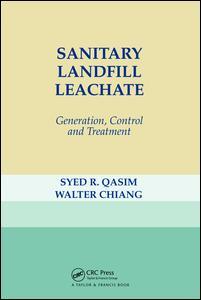Sanitary Landfill Leachate Generation, Control and Treatment
Auteurs : Qasim Syed R., Chiang Walter

FROM THE PREFACE
Sanitary landfills are the most widely utilized method of solid waste disposal around the world. With increased use and public awareness of this method of disposal, there is much concern with respect to the pollution potential of the landfill leachate. Depending on the composition and extent of decomposition of the refuse and hydrological factors, the leachate may become highly contaminated. As leachate migrates away from a landfill, it may cause serious pollution to the groundwater aquifer as well as adjacent surface waters. There is growing concern about surface and groundwater pollution from leachate. Better understanding and prediction of leachate generation, containment, and treatment are needed.
This book contains a literature review of various methodologies that have been developed for prediction, generation, characterization, containment, control, and treatment of leachate from sanitary landfills. The contents of this book are divided into nine chapters. Each chapter contains theory and definition of the important design parameters, literature review, example calculations, and references.
Chapter 1 is devoted to basic facts of solid waste problems current status and future trends towards waste reduction and recycling. Chapter 2 provides a general overview of municipal solid waste generation, collection, transport, resource recovery and reuse, and disposal options. The current status of sanitary landfill design and operation, problems associated with the landfilling, and future trends are presented in Chapter 3. Methods of enhanced stabilization, recycling landfill space, methane recovery, and above grade landfilling, and closure and post closure care of completed landfills are also discussed in detail. Chapter 4 provides a general overview of Subtitle D regulations and its impact upon sanitary landfilling practices. Chapter 5 is devoted entirely to moisture routing and leachate generation mechanisms. Examples of calculation procedure for determining the leachate quantity produced at a landfill are presented. Chapter 6 is devoted to chemical characterization of leachate that changes over the life of the fill. Both theoretical and experimental results are provided to estimate the leachate quality. Chapter 7 provides leachate attenuation processes and mechanisms. Chapter 8 is devoted to leachate collection systems. Natural soil sealants, admixed materials and synthetic membranes, their effectiveness, and methods of installation and economics are fully discussed. Chapter 9 provides a detailed review of leachate treatment methodology. Kinetic coefficients and treatment plant design considerations are summarized for the sole purpose of assisting con- sultants to design leachate treatment facilities. Leachate treatment case histories and numerous process trains are presented for treating leachate from young landfill. The book also describes how the process train can be changed effectively as leachate quality changes with time.
Date de parution : 08-2017
15.6x23.4 cm
Mots-clés :
Sanitary Landfill; municipal; Moisture Content; solid; Domestic Wastewater Sludges; waste; TOC Ratio; landfills; Sanitary Landfill Leachate; final; Leachate Collection System; cover; Municipal Solid Waste Landfills; system; High Strength Leachate; owners; Landfill Leachate; amendments; Post Closure Care; fresh; Energy Recovery; Leachate Generation; FML; Leachate Collection; RBC; EPA Estimate; Clay Liners; Landfill Ages; Cod Ratio; Leachate Treatment; Cod Removal; TCLP Test; Free Volatile Fatty Acids; Aerated Lagoon; Leachate Quality



